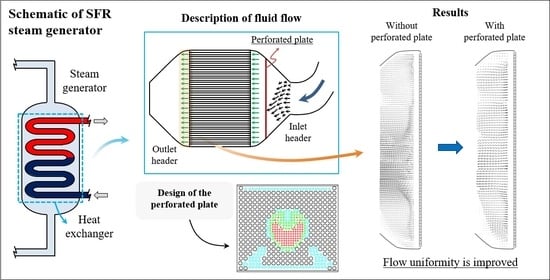Experimental Validation of Flow Uniformity Improvement by a Perforated Plate in the Heat Exchanger of SFR Steam Generator
Abstract
:1. Introduction
2. Research Methodology
2.1. Numerical Design of a Perforated Plate
2.2. Experimental Setup
3. Results
4. Discussion
5. Conclusions
Author Contributions
Funding
Institutional Review Board Statement
Informed Consent Statement
Data Availability Statement
Conflicts of Interest
References
- Technology Roadmap update for Generation IV Nuclear Energy Systems; the OECD Nuclear Energy Agency: Paris, France, 2014; p. 63.
- Development of a Combined Heat Exchanger Design Concept for an SFR Decay Heat Removal System; KAERI: Daejeon, Korea, 2014; p. 171.
- Yoo, J.; Chang, J.; Lim, J.-Y.; Cheon, J.-S.; Lee, T.-H.; Kim, S.K.; Lee, K.L.; Joo, H.-K. Overall System Description and Safety Characteristics of Prototype Gen IV Sodium Cooled Fast Reactor in Korea. Nucl. Eng. Technol. 2016, 48, 1059–1070. [Google Scholar] [CrossRef] [Green Version]
- Im, S.; Hong, J.; Han, J.-W.; Choi, S.R. In Preliminary Development of a Copper Bonded Steam Generator for minimizing a Sodium-Water Reaction. In Proceedings of the Transactions of the Korean Nuclear Society Spring Meeting, Jeju, Korea, 23–24 May 2019. [Google Scholar]
- Nguyen, V.T.; Choi, S.R.; Jung, Y.; Im, S.; Kim, B.J. Design of perforated plate for uniform flow distribution in heat-exchanger unit of SFR steam generator. J. Mech. Sci. Technol. 2021, 35, 3469–3474. [Google Scholar] [CrossRef]
- Jiao, A.; Zhang, R.; Jeong, S. Experimental investigation of header configuration on flow maldistribution in plate-fin heat exchanger. Appl. Therm. Eng. 2003, 23, 1235–1246. [Google Scholar] [CrossRef]
- Gajapathy, R.; Velusamy, K.; Selvaraj, P.; Chellapandi, P.; Chetal, S.; Sundararajan, T. Thermal hydraulic investigations of intermediate heat exchanger in a pool-type fast breeder reactor. Nucl. Eng. Des. 2008, 238, 1577–1591. [Google Scholar] [CrossRef]
- Wen, J.; Li, Y. Study of flow distribution and its improvement on the header of plate-fin heat exchanger. Cryogenics 2004, 44, 823–831. [Google Scholar] [CrossRef]
- Wen, J.; Li, Y.; Wang, S.; Zhou, A. Experimental investigation of header configuration improvement in plate–fin heat exchanger. Appl. Therm. Eng. 2007, 27, 1761–1770. [Google Scholar] [CrossRef]
- Lalot, S.; Florent, P.; Lang, S.; Bergles, A. Flow maldistribution in heat exchangers. Appl. Therm. Eng. 1999, 19, 847–863. [Google Scholar] [CrossRef]
- Khovanskyi, S.; Pavlenko, I.; Pitel, J.; Mizakova, J.; Ochowiak, M.; Grechka, I. Solving the Coupled Aerodynamic and Thermal Problem for Modeling the Air Distribution Devices with Perforated Plates. Energies 2019, 12, 3488. [Google Scholar] [CrossRef] [Green Version]
- Petinrin, M.; Dare, A. Numerical Investigation of the Concave-Cut Baffles Effect in Shell-and-Tube Heat Exchanger. J. Eng. Sci. 2019, 6, e1–e9. [Google Scholar] [CrossRef]
- Petinrin, M.O.; Towoju, O.A.; Ajiboye, S.A.; Zebulun, O.E. Numerical Study of the Effect of Changing Tube Pitches on Heat and Flow Characteristics from Tube Bundles in Cross Flow. J. Eng. Sci. 2019, 6, e1–e10. [Google Scholar] [CrossRef]
- Baek, S.; Lee, C.; Jeong, S. Effect of flow maldistribution and axial conduction on compact microchannel heat exchanger. Cryogenics 2014, 60, 49–61. [Google Scholar] [CrossRef]
- Lance, B.W.; Carlson, M.D. Microchannel Heat Exchanger Flow Validation Study, Turbo Expo: Power for Land, Sea, and Air, 2018; American Society of Mechanical Engineers: Oslo, Norway, 2018; p. V009T38A027. [Google Scholar]
- ANSYS Fluent Theory Guide; ANSYS: Canonsburg, PA, USA, 2016.
- Westerweel, J. Fundamentals of digital particle image velocimetry. Meas. Sci. Technol. 1997, 8, 1379–1392. [Google Scholar] [CrossRef] [Green Version]
- Kim, B.J.; Sung, H.J. A further assessment of interpolation schemes for window deformation in PIV. Exp. Fluids 2006, 41, 499–511. [Google Scholar] [CrossRef]
- Hart, D.P. PIV error correction. Exp. Fluids 2000, 29, 13–22. [Google Scholar] [CrossRef]
- Scarano, F.; Riethmuller, M.L. Iterative multigrid approach in PIV image processing with discrete window offset. Exp. Fluids 1999, 26, 513–523. [Google Scholar] [CrossRef]
- Meade, N. Industrial and business forecasting methods, Lewis, C.D., Borough Green, Sevenoaks, Kent: Butterworth, 1982. Price: £9.25. Pages: 144. J. Forecast. 1983, 2, 194–196. [Google Scholar] [CrossRef]
















| Grid Case | Number of Cells, 106 | CoV | Δp (Pa) |
|---|---|---|---|
| 1 | 46.4 | 0.2401 | 490.2 |
| 2 | 94.1 | 0.2496 | 410.5 |
| 3 | 108.5 | 0.2536 | 378.8 |
| 4 | 122.9 | 0.2512 | 379.3 |
| Perforated Plate | Position | MAPE |
|---|---|---|
| Not installed | Middle plane | 27.5% |
| Side plane | 27.1% | |
| Installed | Middle plane | 28.8% |
| Side plane | 23.6% |
| Perforated Plate | Numerical Simulation | Experiment |
|---|---|---|
| Not installed | 378.8 Pa | 388.1 Pa |
| Installed | 477.2 Pa (20.6% ↑) | 436.7 Pa (11.1% ↑) |
Publisher’s Note: MDPI stays neutral with regard to jurisdictional claims in published maps and institutional affiliations. |
© 2021 by the authors. Licensee MDPI, Basel, Switzerland. This article is an open access article distributed under the terms and conditions of the Creative Commons Attribution (CC BY) license (https://creativecommons.org/licenses/by/4.0/).
Share and Cite
Kim, M.-H.; Nguyen, V.T.; Im, S.; Jung, Y.; Choi, S.-R.; Kim, B.-J. Experimental Validation of Flow Uniformity Improvement by a Perforated Plate in the Heat Exchanger of SFR Steam Generator. Energies 2021, 14, 5846. https://0-doi-org.brum.beds.ac.uk/10.3390/en14185846
Kim M-H, Nguyen VT, Im S, Jung Y, Choi S-R, Kim B-J. Experimental Validation of Flow Uniformity Improvement by a Perforated Plate in the Heat Exchanger of SFR Steam Generator. Energies. 2021; 14(18):5846. https://0-doi-org.brum.beds.ac.uk/10.3390/en14185846
Chicago/Turabian StyleKim, Myung-Ho, Van Toan Nguyen, Sunghyuk Im, Yohan Jung, Sun-Rock Choi, and Byoung-Jae Kim. 2021. "Experimental Validation of Flow Uniformity Improvement by a Perforated Plate in the Heat Exchanger of SFR Steam Generator" Energies 14, no. 18: 5846. https://0-doi-org.brum.beds.ac.uk/10.3390/en14185846







